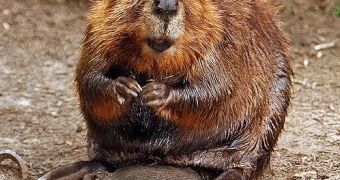In the United States there are many rivers that need restoration, a complicated and expensive task, so a professor from Kansas State University, though of a smaller engineer that could do the job properly and for free – the North American beaver.
Melinda Daniels, an associate professor of geography who recently studied the connection between beavers and river restoration, said that beavers are usually called ecosystem engineers, and this is justified since they can significantly alter stream or valley bottom ecosystems.
Beavers are known to built dams, and by doing so, they create different landscapes, even changing a single-thread channel stream into a meadow, pond or multichannel, free-flowing stream.
“Our argument is that the restoration target for streams with forested riparian zones has got to acknowledge the diversity brought to river systems by active beaver populations,”said Daniels.
“A lot of rivers are in trouble and need work and restoration, but it's amazing how little we know about the systems we're trying to fix.
“We know they're broken, but we don't exactly know what they should look like because we know so little about how many of our river systems function.”
She added that current restoration projects generally ignore the role of beavers, and simply focus on creating continuous free-flowing streams.
The problem is that such restoration can be very expensive and usually, the engineers have to tear down small 19th-century milldams and re-engineer an entire valley bottom.
This is why, researchers recommend that instead of demolishing the milldam completely, thus altering the surrounding ecosystem, the river restorers should only remove part of it.
This will allow some ponded water to remain and mimic the role of beavers.
Daniels explained that in most cases, when an old dam breaks and forms a gap, beavers build their own dam to patch the gap and recreate the previous ecosystem.
Restoring a river is no easy task so the researchers decided to keep observing and collecting as many data as possible, to help river restorers maintain the diversity of river ecosystems.
“You can use these natural analogs to produce an ecosystem that looks a lot more like the one that was there before the colonists arrived,” said Daniels.
“We can restore rivers in a way that mimics the naturally diverse beaver streams, and we can save a lot of money in the process.”
The researcher said that beaver populations have rebounded in recent years, after being close to extinction in the early 19th century, because of excessive hunting.
The main goal of this entire research is to help restore rivers in an efficient way that takes into account ecosystem diversity and doesn't destroy it, and even if this specific study involves watersheds in northeastern Connecticut, the results can apply to any forested stream, with large beaver populations.
Daniels along with the three researchers from the University of Connecticut co-authored "The River Discontinuum: Applying Beaver Modifications to Baseline Conditions for Restoration of Forested Headwaters."
Denise Burchsted at the University of Connecticut, led the article that appears in a recent issue of BioScience, the journal of the American Institute of Biological Sciences.

 14 DAY TRIAL //
14 DAY TRIAL // 
